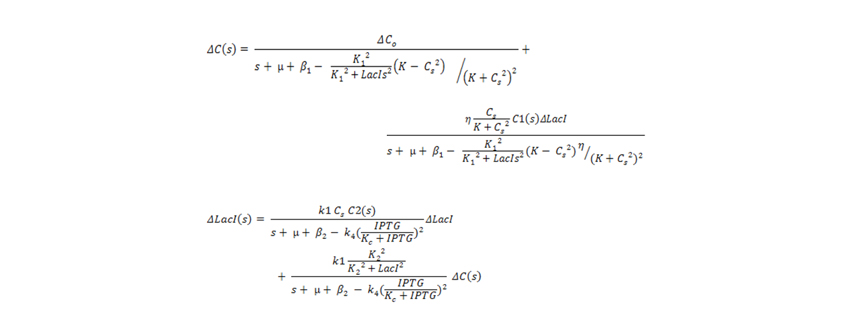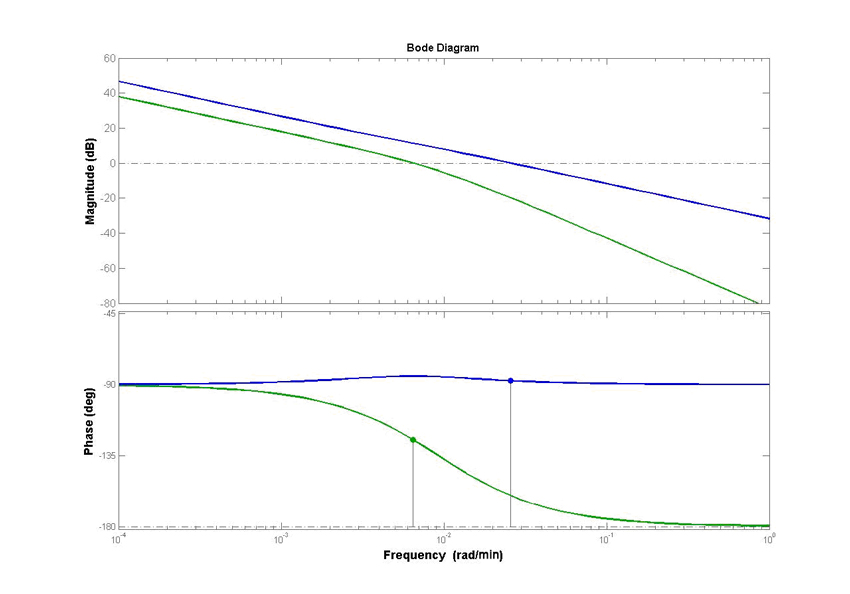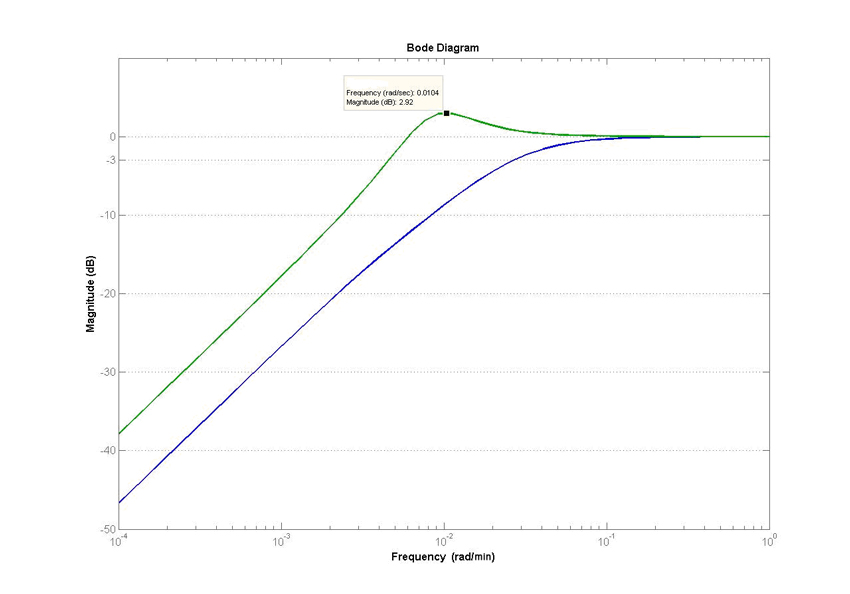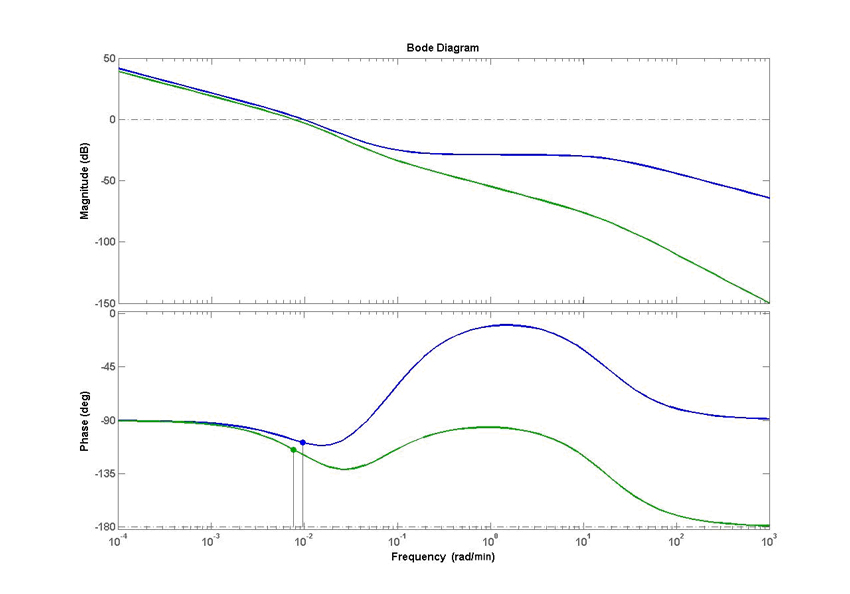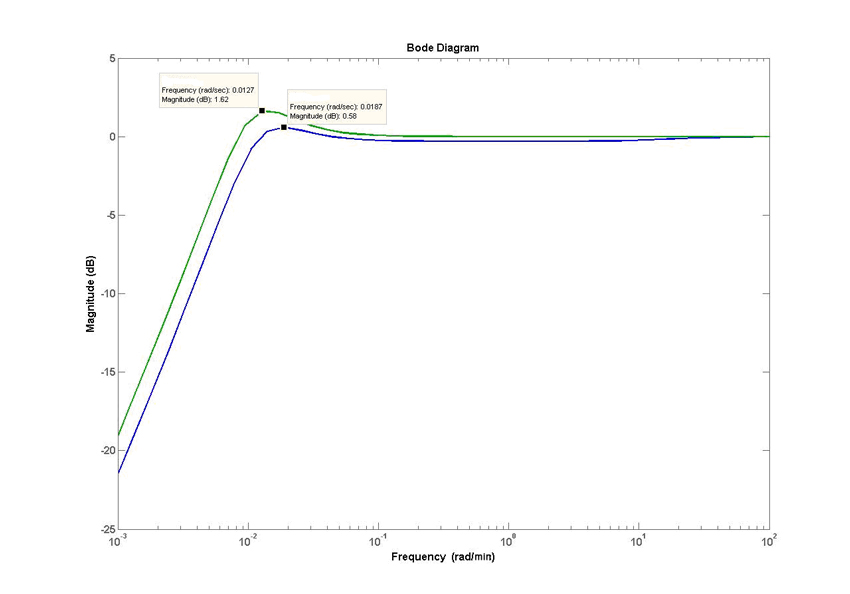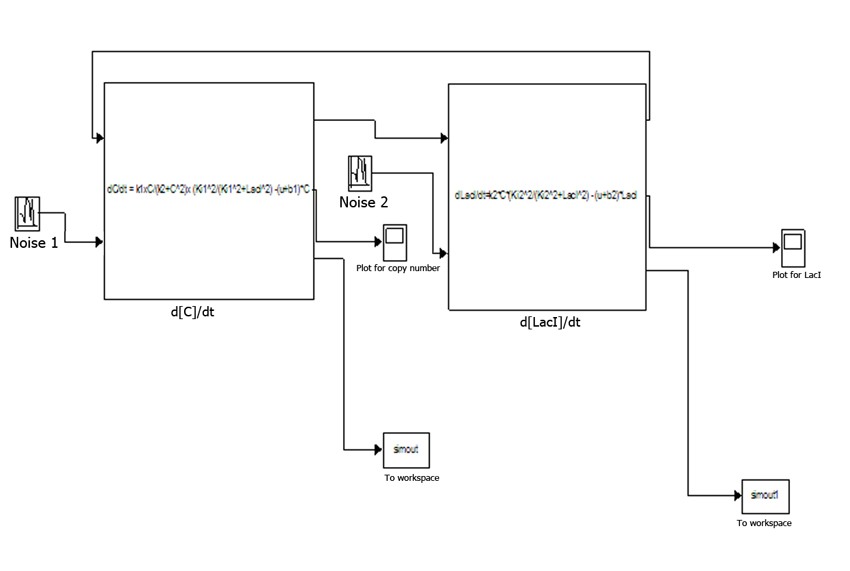Team:IIT Bombay India/CAM
From 2009.igem.org
Pranayiitb (Talk | contribs) |
Pranayiitb (Talk | contribs) |
||
| Line 89: | Line 89: | ||
[[Image:shetty2.jpg]] | [[Image:shetty2.jpg]] | ||
[[Image:shetty3.jpg]] | [[Image:shetty3.jpg]] | ||
| - | ''Fig: Magnitude, phase and sensitivity bode plots for LacI system given in linear model. The green line represents | + | ''Fig: Magnitude, phase and sensitivity bode plots for LacI system given in linear model. The green line represents Strain 3 with only C1(s), while blue line represents Strain 4 with both C1(s) and C2(s). The gain margin for both Strain 3 and Strain 4 is ∞.'' ''The phase margin is 92.2 degree for Strain 4 and 56 degree for Strain 3. The increased bandwidth from 0.00428 rad/min to 0.0255 rad/min indicates faster response and improved noise rejection.'' ''The Strain 3 has higher peak of 2.92 dB while Strain 4 has no peak, again indicating better noise-attentuation. |
'' | '' | ||
| Line 95: | Line 95: | ||
1. The phase margin for a distributed, multiple feedback system (DFS) is 92.2 degree, while it is 56 degree for a single, conventional feedback system (CFS). | 1. The phase margin for a distributed, multiple feedback system (DFS) is 92.2 degree, while it is 56 degree for a single, conventional feedback system (CFS). | ||
| - | 2. The bandwidth increases from 0.00428 rad/min to 0.0255 rad/min for | + | 2. The bandwidth increases from 0.00428 rad/min to 0.0255 rad/min for Strain 3 to Strain 4. |
| Line 103: | Line 103: | ||
[[Image:shetty4.jpg]] | [[Image:shetty4.jpg]] | ||
[[Image:shetty5.jpg]] | [[Image:shetty5.jpg]] | ||
| - | ''Fig: Magnitude, phase and sensitivity bode plots for LacI system with 1000 µM IPTG for linear model given in Fig 2.'' ''The green line represents | + | ''Fig: Magnitude, phase and sensitivity bode plots for LacI system with 1000 µM IPTG for linear model given in Fig 2.'' ''The green line represents Strain 3 with only C1(s), while blue line represents Strain 4 with both C1(s) and C2(s).'' ''The gain margin for both Strain 3 and Strain 4 is ∞.'' ''The phase margin is 70 degree for Strain 4 and 64 degree for Strain 3.'' ''The bandwidth increase is not significant for Strain 4 from 0.0061 rad/min to 0.0078 rad/min indicates hardly any difference in noise rejection.'' ''The Strain 3 has higher peak of 1.62 dB while Strain 4 has a peak at 0.58 dB indicating a lower peak and a slight better performance in noise attentuation.'' |
| - | 1. The phase margin for | + | 1. The phase margin for Strain 3 and Strain 4 are 64 degree and 70 degree respectively. |
| - | 2. The bandwidth for | + | 2. The bandwidth for Strain 3 and Strain 4 are 0.0061 rad/min and 0.0078 rad/min respectively. |
| Line 114: | Line 114: | ||
''Fig: Simulink block model for LacI system with external noise.'' ''For noise in replication of plasmid copy number, mean is 0, and variance is 10 for multiple feedback and 62.5 for open-loop systems respectively.'' ''For noise in production of plasmid copy number, mean is 0, and variance is 10 for multiple feedback and 18779 for open-loop systems respectively.'' ''The standard-deviation/mean value of the LacI is used to characterize the noise at the output.'' | ''Fig: Simulink block model for LacI system with external noise.'' ''For noise in replication of plasmid copy number, mean is 0, and variance is 10 for multiple feedback and 62.5 for open-loop systems respectively.'' ''For noise in production of plasmid copy number, mean is 0, and variance is 10 for multiple feedback and 18779 for open-loop systems respectively.'' ''The standard-deviation/mean value of the LacI is used to characterize the noise at the output.'' | ||
| - | With external noise in the replication of copy number the normalised standard deviation is | + | With external noise in the replication of copy number the normalised standard deviation is 43.67% for multiple-feedback system and 82.28% for open-loop system in terms of external white noise. |
| - | With external noise in the production of LacI the normalised standard deviation is 5 | + | With external noise in the production of LacI the normalised standard deviation is 136.5% for multiple-feedback system and 151.78% for open-loop system. |
| - | With external noise in the production of LacI and the replication of copy number the normalised standard deviation is | + | With external noise in the production of LacI and the replication of copy number the normalised standard deviation is 44.59% for multiple-feedback system and 83.18% for open-loop system. |
| Line 124: | Line 124: | ||
'''Interpretation''' | '''Interpretation''' | ||
| - | 1. The increased phase margin for | + | 1. The increased phase margin for Strain 4 indicates that Strain 4 can take care of delays in production LacI directly and by virtue of production of multiple plasmid copies better than the Strain 3 which has regulation only on the plasmid copy number. |
2. This indicates faster expression of the protein LacI in the system with low noise. | 2. This indicates faster expression of the protein LacI in the system with low noise. | ||
| - | 3. The increased bandwidth nearly 6 times for | + | 3. The increased bandwidth nearly 6 times for Strain 4 indicates a faster response and a better noise rejection over a wide range of frequencies indicating a far robust response as compared to Strain 3. |
4. For system with higher IPTG concentrations, IPTG takes away LacI, and thus acting as an inducer. This makes the system resemble open loop system more as compared to IPTG at lower concentrations. | 4. For system with higher IPTG concentrations, IPTG takes away LacI, and thus acting as an inducer. This makes the system resemble open loop system more as compared to IPTG at lower concentrations. | ||
| - | 5. The phase margin of | + | 5. The phase margin of 70 degree and 64 degree for Strain 4 and Strain 3 respectively indicates the difference in ability to take care of delays in the two systems has reduced. The bandwidth increase for Strain 4 is not high as compared Strain 3, with IPTG concentration of 1000μM. Also, the bandwidth for Strain 4 with1000μM IPTG is far lower as compared to the bandwidth of Strain 4 with no IPTG. |
6. In presence of external noise, the multiple-feedback system attenuates noise at the output better than open-loop system. | 6. In presence of external noise, the multiple-feedback system attenuates noise at the output better than open-loop system. | ||
Revision as of 01:38, 22 October 2009
| Home | The Team | The Project | Analysis | Modeling | Notebook | Safety |
|---|
Control Theory Approach to Study Multiple Feedbacks on Lac-operon |
| Control Analysis Model
1. Characterize the system. 2. Linearize the system around a set-point on LacI. 3. Obtain a linear model in transfer-function (s) domain. 4. Frequency response analysis using magnitude and phase bode plots. 5. Sensitivity analysis using magnitude bode plot for sensitivity function. 6. Steps 2-5 for 1000μM IPTG. 7. Add external noise in the system and tried to determine the reduction in the noise for the system with multiple feedbacks and open-loop system.
We have 2 control levels. By combination, we have 4 different control loops or structures possible, expressed in 4 different strains. They are as follows:- Strain 1 (Open loop) with plasmid (BBa_K255004) It has got open loop without any feedback.re there is constitutive expression of LacI.
It has got a single negative feedback loop. So the expression of LacI is under regulation. Here also the copy number of the plasmid is fixed.
It has got a single negative feedback loop on the feedback copy number. Here there is no control on the LacI expression.
It has dual negative feedback loop one on the plasmid copy number and second on the LacI expression.
The linearized system in transfer-function (s) domain is as given below:
The magnitude and phase bode plots for the system is given below:
2. The bandwidth increases from 0.00428 rad/min to 0.0255 rad/min for Strain 3 to Strain 4.
1. The phase margin for Strain 3 and Strain 4 are 64 degree and 70 degree respectively. 2. The bandwidth for Strain 3 and Strain 4 are 0.0061 rad/min and 0.0078 rad/min respectively. Fig: Simulink block model for LacI system with external noise. For noise in replication of plasmid copy number, mean is 0, and variance is 10 for multiple feedback and 62.5 for open-loop systems respectively. For noise in production of plasmid copy number, mean is 0, and variance is 10 for multiple feedback and 18779 for open-loop systems respectively. The standard-deviation/mean value of the LacI is used to characterize the noise at the output. With external noise in the replication of copy number the normalised standard deviation is 43.67% for multiple-feedback system and 82.28% for open-loop system in terms of external white noise. With external noise in the production of LacI the normalised standard deviation is 136.5% for multiple-feedback system and 151.78% for open-loop system. With external noise in the production of LacI and the replication of copy number the normalised standard deviation is 44.59% for multiple-feedback system and 83.18% for open-loop system.
Interpretation 1. The increased phase margin for Strain 4 indicates that Strain 4 can take care of delays in production LacI directly and by virtue of production of multiple plasmid copies better than the Strain 3 which has regulation only on the plasmid copy number. 2. This indicates faster expression of the protein LacI in the system with low noise. 3. The increased bandwidth nearly 6 times for Strain 4 indicates a faster response and a better noise rejection over a wide range of frequencies indicating a far robust response as compared to Strain 3. 4. For system with higher IPTG concentrations, IPTG takes away LacI, and thus acting as an inducer. This makes the system resemble open loop system more as compared to IPTG at lower concentrations. 5. The phase margin of 70 degree and 64 degree for Strain 4 and Strain 3 respectively indicates the difference in ability to take care of delays in the two systems has reduced. The bandwidth increase for Strain 4 is not high as compared Strain 3, with IPTG concentration of 1000μM. Also, the bandwidth for Strain 4 with1000μM IPTG is far lower as compared to the bandwidth of Strain 4 with no IPTG. 6. In presence of external noise, the multiple-feedback system attenuates noise at the output better than open-loop system. The detailed methodology, system equations, results and discussion can be seen here. |
 "
"


